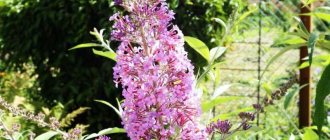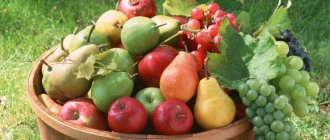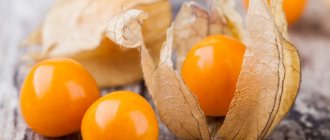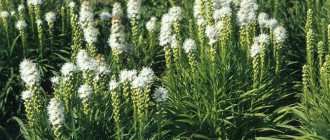Flowering shrubs with white flowers are essential for creating stylized gardens. Snow-white shades are a symbol of purity, honesty and ambition. Gardens and front gardens in white look incredibly beautiful and attractive. Luxurious white-blooming shrubs add richness and light to the landscape. In such a plot, the sun will always be a long-awaited and permanent guest. In this issue we will find out the nine best shrubs with white flowers, which are very popular and which ones are best used for growing in the summer garden.
The photos and names presented on the page will help you understand the variety of similar crops for the garden. Useful tips on agricultural technology and growing on your own plot will allow you to create beauty with your own hands. Well, a brief description of shrubs with white flowers, their photos and names will help you make the right choice at the fair for gardeners.
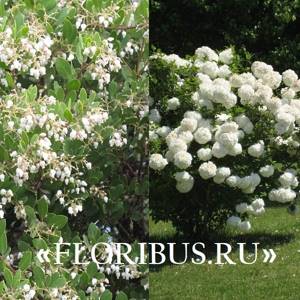
Look at this photo of shrubs blooming in white
Fothergilla is a luxurious shrub that blooms with white flowers.
This is a luxurious plant with fragrant brush inflorescences. Landscape designers value fothergilla for its delicate appearance and good resistance to the Russian variable climate. But few varieties have this characteristic. The main ones freeze even in St. Petersburg. Therefore, they try to grow fothergilla carefully in greenhouses or in private collections. This shrub, blooming with white flowers, has a natural habitat of North America, where the climate is warm and conditions are mild. But, thanks to modern selection, varieties and species have been developed that easily take root in cold regions.
Fothergilla belongs to the Witch Hazel family. This shrub with white flowers is very rare in private collections of gardeners. Only 2 or 3 natural species are known. The rest are hybrids. The perennial shrub is a low plant - no more than 1-3 meters in height. The leaf plates are neat, oval in shape, attached by elastic petioles to woody shoots. In autumn, the crown turns bright orange and red tones.
The flowering period of fothergilla occurs in spring. At this time, the perennial produces numerous small flowers, collected in white brush inflorescences at the tips of the stems. The bud is a snow-white and very fragrant stamen. It exudes a rich honey scent.
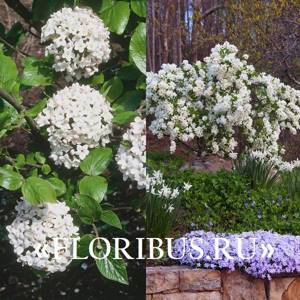
The following species are known in culture: Large, Indian and Gardena. They all originate from North America. Fothergilla Large is the most fastidious and tall. It grows up to 3 meters in height at maturity. Fothergilla Gardena is more compact - no more than 1 m. The Indian species is the most whimsical and rare. It grows exclusively in the wild nature of the Indian Peninsula.
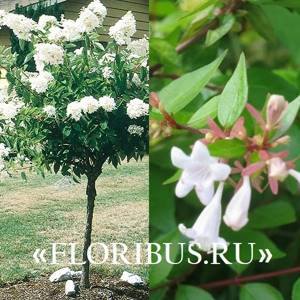
Choosing bush flowers for the garden
Bush flowers give the garden a luxurious layering and lushness. Nowadays, breeders have developed various garden bush varieties, the abundance of which is not easy to understand. They vary in height, flowering and growing conditions, so in this splendor you can always choose a plant that is ideal for your garden design. All varieties of flowers are conventionally divided into perennial and annual.
Shrub perennials can grow for several years, among them there are wintering and non-wintering, let's look at these groups and their most prominent representatives. Wintering perennials. The name suggests that these bush crops can overwinter in open ground, some of them require minimal shelter, while others tolerate frost well without any preparation.
Weigela family Honeysuckle
This shrub with white flowers is used in Russian culture more often than fothergilla. Weigela is not so fastidious in care. It easily adapts to any conditions. The perennial shrub belongs to the Honeysuckle family. About 15 varieties are known, 3 of them are actively found in the forests of Russia as wild plants. In cultivation, plants with white or pink flowers are mainly used.
The stems of Weigela are powerful, they form a spreading shrub blooming with white flowers. The plant needs to be constantly looked after and updated with trimmings. Without this procedure, the perennial grows greatly and may lose its decorative effect. The leaf plates are located opposite. Leaves with shoots and long petioles are attached. The plate is oval in shape with jagged or serrated edges.
Weigela blooms for a long time with small pink and white flowers. The buds are usually single on long peduncles. Some varieties may produce small, loose inflorescences. In gardening, compact shrubs, no more than 1.5-2 meters high, are mainly grown. Weigela is a great addition to a garden or front garden. It can be planted next to lilacs and other interesting varieties of flowering shrubs.
Look at the shrubs with white flowers in the photo and continue to get acquainted with their names:
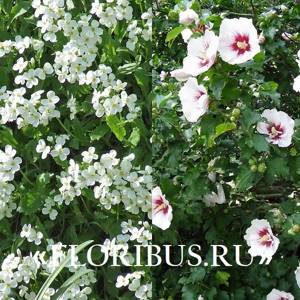
Shrubs, subshrubs, shrubs
A shrub is a low-growing tree-like plant that does not have a main trunk. The shrub has several hard stems covered with bark. The branches of the bush start almost from the very surface of the soil. Shrubs are perennial plants.
In forests, shrubs usually occupy the undergrowth. Since much less sunlight reaches the understory, the plants there are shade-loving and are able to perform photosynthesis in limited light. The undergrowth is very important for forest life. Falling leaves of shrubs enrich the forest soil with nutrients, make it loose, form a layer of litter that protects the soil from freezing and overheating, and retains soil moisture. Shrubs in the forest and park create favorable conditions for nesting birds, which destroy harmful insects. Many shrubs produce edible and medicinal berries and seeds that people and wildlife need. In the forest, bushes help animals and birds hide from enemies; under their protection, animals make their burrows, lairs, and beds.
In addition, growing in dense clumps under the canopy of trees, shrubs protect the soil from excessive trampling, surface roots from damage, and thereby improve the living conditions of trees.
In gardens, parks, and public gardens, shrubs are usually planted for decorative purposes. Some shrubs make beautiful hedges, which can even be trimmed without much damage to the plant.
There are many species and forms of shrubs growing in our country. Among them there are many with beautiful and fragrant flowers, with leaves and fruits of various colors and shapes. The most common for the forests of the middle zone are honeysuckle, buckthorn, warty euonymus, viburnum, hazel, raspberry, currant, and rose hip.
In parks and squares, the most common forms of mock orange, hawthorn, spirea, cotoneaster, and lilac are found. Some Far Eastern species of shrubs are very good, for example Amur maple, or ginnala.
Shrubs up to 50-60 cm high with woody and usually strongly branched shoots, often with long rhizomes, are called shrubs - these are lingonberries, cranberries, blueberries, as well as andromeda, heather, etc. Shrubs predominate in the vegetation cover of the tundra. They often form a continuous layer in coniferous forests and sphagnum bogs.
Many shrubs provide us with valuable edible berries, which also serve as important food for animals and birds. The continuous cover formed by shrubs in moss swamps and coniferous forests is easily destroyed. It takes a long time to restore it. In addition, shrubs are very sensitive to any environmental change. Therefore, you need to treat them very carefully, do not break them, do not trample them when picking berries.
Low shrubs, no more tall than grass, which seem to creep along the ground, are called subshrubs . In subshrubs, unlike shrubs and dwarf shrubs, only the lower part of the shoots, bearing renewal buds, becomes woody and remains in the winter for many years, and the upper part - herbaceous - dies off every year with the onset of cold weather, and grows back with the onset of warmth.
Examples of subshrubs: teresken, many types of steppe and desert wormwood, astragalus, saltwort (sarsazan, potashnik). Depending on the species, blueberries can be a shrub, a subshrub, or even a shrub.
Lilac with white flowers
This shrub is perhaps the most popular among all the others. Lilac belongs to the Olive family. She captivates with her aroma. By the way, shrub varieties with white flowers are more fragrant. In Russia, lilacs of such varieties are very rare. Mainly white varieties with small flowers collected in elegant inflorescences are grown in the Moscow region.
There are about 30 varieties of lilac known in the world. Thanks to its unusually beautiful appearance, breeders over the many years of their work have created many of the most beautiful and fragrant varieties. There are also shrubs blooming with white flowers. Basically, these are perennials that are quite whimsical to climatic conditions. Also, flower growers point out that with white flowers, lilac bushes are more compact and neat. The most famous varieties include the following:
- "Miss Helen Wilmot" is a beautiful shrub that blooms with snow-white flowers in racemes. This perennial is large and very fragrant. There are a lot of inflorescences. The flowering period occurs in spring and early summer. The variety is whimsical and to maintain its decorative effect it is necessary to monitor the external environment.
- “Beauty of Moscow” is a variety bred by Kolesnikov. It was thanks to him that the breeder received the “Golden Branch of Lilac” award. This is a luxurious compact plant with snow-white double flowers in racemose apical inflorescences. The variety is not capricious and is easy to grow in greenhouses and gardens.
- Varieties of the Amur lilac variety - almost all bloom with white and bluish flowers in clusters. This species is thermophilic. In warm regions it is long-lived. In cool climates it develops much more slowly and requires shelter for the winter.
PLANTING A GARDEN Everything you wanted to know about DIY landscape design
Added 04/30/2014 beautiful flowering shrubs, summer, review Reduce text size Increase text size Text size Print Send by mail
A flowering bush in the garden undoubtedly attracts attention or highlights neighboring plants. But many are accustomed to the fact that shrubs can bloom only at one time, and then only take up space, although in fact this is not the case.
1. Mock orange ( lat.Philadelphus
) - a plant that most people know as “jasmine” - is one of the most common and winter-hardy flowering plants for central Russia.
Mock orange has an incredible number of varieties, differing in different heights of the bush, size of flowers and shade of leaves. But when choosing a seedling, preference should be given to domestic varieties bred in the Soviet Union, since they are guaranteed (unlike French varieties) to withstand Russian winters without loss. Pearl
variety should be highlighted : the maximum height of the bush is about one and a half meters, the flowers are large, double.
Bushes of the “Snowstorm” variety reach
two meters in height, and the flowers are smaller, but numerous, giving the impression that the bush is covered with snow.
" Blizzard
" can bloom for up to twenty days.
Flowering time: June-July (depending on the variety). Height: 1.5-2 meters.
Care: regular removal of old shoots (over two years); after flowering, removal of damaged shoots directed inward; monthly feeding with humus or mineral fertilizer.
2. Lilac ( lat. Syrínga
) is extremely common in Russian gardens and without proper control and pruning it often grows to the size of trees.
To prevent this from happening and for the lilac to remain a profusely flowering and well-formed shrub, it requires regular pruning. In early spring, when buds have appeared on the bush and future flowering branches are visible, identify a dozen strong shoots on the bush that will determine the shape of the bush, cut off all the rest. In this case, it is better to shorten some external shoots to the border of the main branches. Of the white-flowering varieties, the terry lilac variety "Alice Harding" is recommended ;
Condorcet
' blooms most profusely and unpretentiously .
Paul Thirion
blooms most luxuriantly . All listed varieties are winter-hardy and decorative.
Flowering time: June.
Height: 1.5-3 meters.
Care: after flowering, remove damaged shoots directed inward; spring feeding three times with a solution of bird droppings at intervals of three weeks.
Lilac "Alice Harding"
«
3. Japanese quince ( lat. Chaenomeles japonica
) is conditionally frost-resistant: this means that a harsh winter can damage the plant. Those shoots that are above the snow level may freeze, and the plant will not bloom magnificently. The decorative effect of the shrub is given not only by its beautiful flowering, but also by its flexibility to be pruned. Every spring, sanitary pruning is required: all dry, lifeless shoots are cut off, including those damaged by frost. The shaped formation of a bush can begin at the age of five, mercilessly removing shoots creeping along the ground and vertical or going deep into the bush. But in no case should you cut off the horizontal shoots that form the “cap” of the bush. After removing all unnecessary shoots, the remaining ones will be filled with more energy. Upon reaching ten years of age, the Japanese quince bush is rejuvenated: the bush must be thinned out, reducing the number of branches to the ten strongest.
Flowering time: May, early June. Height: up to 1 meter.
Care: for more luxuriant flowering, loosen the soil at the roots to a depth of 10 cm and mulch the root area.
Japanese quince in bloom
4. Spiraea ( lat. Spiraea
) is a very attractive, profusely flowering plant, extremely low maintenance.
There are two main varieties of spirea - spring-blooming and summer-blooming. Spring-blooming spireas usually have numerous white flowers, under the weight of which the bush takes on a cascading shape. All spring-blooming spirea undergo shoot pruning after flowering. In May it blooms. Thunberg, in June - p. Arguta and s. Van Gutta. Summer-blooming spirea have pink flowers, and their flowering usually begins in July. Of the relatively miniature spireas, it is recommended to pay attention to varieties with. Japanese " Golden Princess
" and "
Shirobana
" - their height is no more than 70 cm. The longest blooming time (from July to October) is with. Billard, but such a shrub reaches a height of up to two and a half meters.
Flowering time: May-October (depending on variety). Height: 0.5 – 2.5 meters.
Care: the plant does well without fertilizers, only pruning is required; spring-blooming spireas are pruned only for sanitary purposes after flowering; Summer-blooming spireas are pruned from below in early spring from the fifth year of life.
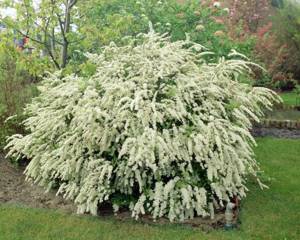
Spiraea Wangutta
5. Buddleja ( lat. Buddlej a
) deserves special attention for its flowering time alone. There are not so many shrubs that bloom in autumn. Although buddleia is heat-loving, with proper preparation for winter (hilling up, insulating the roots, covering it with spruce branches), it is able to survive the average winter and delight the eye with its flowering next year. You should pay attention to the numerous varieties of Buddleia David.
Flowering time: July–October. Height: 0.5 - 3 meters.
Care: sanitary pruning is necessary, remove reddish branches; Curly haircut possible; to stimulate growth - mineral fertilizers monthly; if the height of the bush has reached the desired level, it is enough to stop feeding; pay attention to preparing for winter.
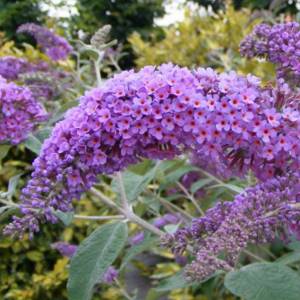
Buddleya David "Empire blue"
«
6. Hydrangea ( lat.Hydr a ngea
) is more like a small tree, but it can also be formed into a shrub. The easiest to care for and winter-hardy is the Tree hydrangea (Hydrangea arborescens), one of its popular varieties is “Annabelle”. She also responds very positively to pruning. In the fall, after flowering ends, all non-lignified branches and all thin shoots are cut off. In the spring, with the beginning of spring work, fresh shoots are shortened to the outermost bud. Other types of hydrangeas are no less popular - large-leaved, paniculate and petiolate.
Flowering time: August—September. Height: up to 2 meters.
Care: mandatory pruning; fertilizing with a special fertilizer for hydrangeas containing iron and magnesium.
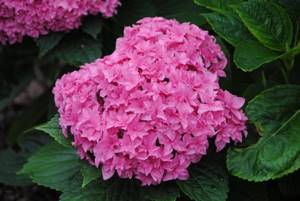
Hydrangea macrophylla 'Perfection'
7. Cinquefoil ( lat. Potentilla
) also known as "Kuril tea", is a widespread shrubby plant. All types of cinquefoil (Potentilla fruticosa) are winter-hardy and not fussy, so the choice depends entirely on color preferences. For yellow-orange flowering, varieties “Dakota sunrise”, “Goldfinger”, “Goldstar”, “Katherine Dykes” are suitable. From white-flowering cinquefoils you can also use “Abbotswood”, from pink ones - “Pink beauty”.
Flowering time: May-August. Height: up to 1.5 meters.
Care: ensure good drainage in the soil; spring fertilizing with mineral fertilizers; in spring, shoots are shortened by about one-third of their length; In summer, regular pruning of weak shoots and faded inflorescences.
8. Rhododendron ( lat. Rhododendron
) is one of the most popular flowering shrubs, but at the same time one of the most difficult, and in order for rhododendron to decorate the garden with its lush blooms as far as possible, it is necessary to follow the secrets of its cultivation.
Rhododendrons have three varieties: evergreen, wintering (semi-evergreen) and deciduous. When choosing a shrub for a garden in central Russia, you should focus on deciduous forms. The most winter-hardy varieties are “Lemon Lights” (“ Lemon lights
”) and “Mandarin Lights” (“
Mandarin lights
”). If you still take a chance and try to grow evergreen rhododendrons in the garden, then it is better to choose the hybrid “Mikkei” (‘Mikkeli’) of Finnish selection, which has proven itself well recently. Depending on the variety, growing conditions vary, but the correct position is guaranteed to be light partial shade during the hottest part of the day (for example, shade from trees or gazebos) and protection from the wind (for example, a fence or wall of a house).
Flowering time: June-July. Height: up to 3 meters.
Care: careful feeding after two years of age with slightly nitrogenous fertilizers without calcium; Organic acid (1g/3l of water) can be added to the water for regular watering; rainwater heated in the sun can be watered; the ground around the bush must be mulched with peat and weeds must be removed manually; removing dried inflorescences; It is better to cover it for the winter.
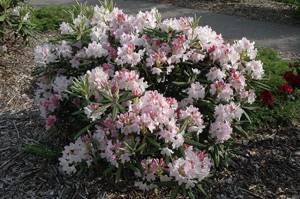
Rhododendron evergreen "Mikkeli"
«
9. Heather ( lat.Call u na
) is a low, creeping shrub that blooms, as a rule, in late summer and early autumn. The key to success in growing heather in the garden is the right soil. Heather is a forest plant, which means it needs forest conditions: peat, sand, pine needles, sawdust. Moreover, it is not enough to add a mixture of the above materials to the usual soil of the garden; the usual soil in the garden in the heather area must be completely replaced with one that suits it. After replacing the soil, it must be moistened with a solution of apple cider vinegar and water (100g/10l of water). The most promising varieties are Allegro, Mullion and Alba Plena.
Flowering time: July–October. Height: half a meter.
Care: watering with oxidized water once a week; fertilizing in the spring with dry mineral fertilizers, scattering at the roots and mulching with bark; weeding from weeds as they appear; pruning in early spring, if it is necessary to give the future bush a special shape, although the heather itself spreads very decoratively; shelter for the winter with spruce paws.

Common heather "Allegro"
Common heather "Allegro"
10. Wrinkled rose ( lat. R o sa rug o sa
) is a wild shrub, better known as “rose hip”.
This rose is unpretentious to soils, but prefers sunny places. The two oldest varieties are popular: the snow-white terry “ White Grootendorst
” and the burgundy-raspberry “
Grootendorst Supreme
”.
There are also hybrid varieties: yellow rose of the variety " Agnes
", purple - "
Hansa
", delicate pink flowers of the variety 'Abelzieds
'
.
Flowering time: June-July. Height: up to 2.5m.
Care: a young plant needs to be watered once a week, and with the onset of three years of age, watering is necessary only during the driest periods; fertilizing with organic matter and mineral fertilizers is extremely rare, no more than once a year in early autumn and only after the age of two; to preserve decorativeness and abundant flowering, regular pruning is necessary from the third year after planting, it is necessary to remove all weak branches, and pinch the tops of the remaining shoots to create a lush bush; does not need shelter for the winter.
Rose wrinkled "Hansa"
These are just some of the most beloved and most proven caring and pruning shrubs that can be used in the garden. Having thought through the plan, you can create such combinations that the garden will always have shrubs blooming all summer and even part of the fall.
Volkova Ekaterina
© 2014 - 2015, Planting a Garden. All rights reserved.
Related Posts
Rose is a holiday all summer!
How do rhododendrons overwinter?
Fragile harbingers of spring
Interesting
Compact deutzia shrub
An incredibly beautiful compact shrub with white flowers and a long flowering period. In the wild, a representative of the Hydrangeaceae family can reach 4 meters in height. Its natural habitat is Asia. There are 50 varieties known in the world. In Russia, only a few are used, which are distinguished by their frost resistance and unpretentious nature. In adulthood, deutia is a spreading shrub with woody stems.
The leaf blades are dark green. The leaves are arranged oppositely, attached to the shoots with short petioles. They become an excellent backdrop for beautiful snow-white flowers. The buds have no aroma. The only disadvantage of choosing such a shrub is that it blooms only after reaching 25 years of age. Of course, you can purchase an adult plant, which modern markets allow. Flowering begins in late spring and ends after 2-4 weeks.
Before the deutzia blooms, the perennial closely resembles honeysuckle. There are known short and tall varieties. The former are often grown to decorate borders. Tall deutzia can often be seen as solitary plantings.

Magnolia - a luxurious shrub
The most luxurious and delicate shrub with white flowers, but it is more often grown in private greenhouses. In open ground, especially in our changeable climate, the plant will experience troubles. Cold and strong winds, periodic heavy rains can have a detrimental effect on the development of magnolia. Therefore, they try to grow a delicate shrub from the Magnoliaceae family in captivity.
Magnolia stems are covered with smooth, dark brown bark. The shoots are elastic and woody. They form a dense bush. The leaf blades are green, located opposite on the petioles. The leaf shape is oval or elliptical. The plate is smooth with clear veins.
The flowering period of magnolia occurs in the warm season. White, very fragrant flowers reach up to 12 cm in diameter. The petals are snow-white or with a light yellow coating, layered on top of each other, creating the effect of a multi-layered corolla. Varieties with pink buds are more common. Petals falling to the ground form a carpet. The fact is that the flowers do not fade for a long time, and the leaves die only after a few days.

Types and varieties
Forsythia first appeared in Russian gardens in the middle of the 19th century, but at that time only heat-loving varieties were known, so the plant was grown in pots. In the first half of the 20th century. Winter-hardy species of deciduous shrubs are beginning to be cultivated in open ground. Let's consider the most popular types and garden forms of plants.
- Forsythia ovoid or oval is one of the most winter-hardy members of the family, therefore it is better suited than others for growing in regions with cold climates. The dense compact bush will grow quickly and bloom very early - in the southern regions in the first ten days of April, in the Moscow region - in May. Thanks to its unpretentiousness to growing conditions and drought resistance, it remains decorative throughout the entire growing season. Based on F. ovate, numerous varieties that are loved by gardeners have been bred: the very early Tetragold, the especially frost-resistant Goldzauber, the large-flowered Parkdecor and Vic End, and the miniature Melissa.
- Forsythia hanging or drooping is distinguished by long flexible stems and great growth energy, and is considered cold-resistant. In the middle zone, in order to avoid freezing of flower buds, the shrub requires shelter or at least bending the branches to the ground so that they are under the snow. In the Crimea, the Caucasus, and southern Russia, hanging flowers are allowed to hang along a trellis, using a house wall or fence as a support.
- Forsythia intermediate is a hybrid obtained from crossing several species, the second name is F. average. The shrub is vigorous, with large dark green leaves and bright yellow flowers, frost- and drought-resistant. It has many interesting garden forms, the name of which speaks for itself - F. densely flowered, F. primrose, F. wonderful. Of the foreign varieties, Linwood forsythia is popular - a spreading, abundantly flowering shrub, forming spherical bushes with a diameter of up to 3 m. The plant attracts not only early flowering, but also unusual purple-violet foliage in the autumn. The Fiesta and Variegata varieties with unusual variegated leaves deserve attention.
- European forsythia is a heat-loving species, sensitive to sub-zero temperatures; in cold climates, flower buds can freeze even in shelter. In cultivation, the shrub is common in the southern regions and is characterized by early and long flowering (up to 25 days).
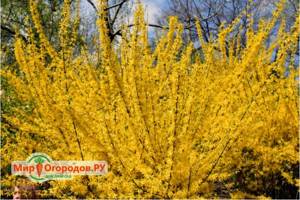
This is interesting! In addition to the traditional forms with yellow flowers, there are varieties with other colors - pink and white forsythia. This is a separate species native to the Korean Peninsula and is known as Abelolifolia biseriata. Rarely found in the middle zone.
Viburnum - a symbol of female beauty
This is the most frost-resistant plant. The symbol of female beauty can withstand frosts down to -35 degrees without shelter. On the contrary, some varieties of Viburnum bloom even brighter and more attractive after a long wintering period. There is an opinion among flower growers that the flowers of this plant symbolize feminine beauty and simplicity. Viburnum belongs to the Adoxaceae family. A total of 163 species are known and included in the genus Viburnum. Many of them are used as ornamental plants. Viburnum is also grown to obtain medicinal raw materials from bitter fruits.
Viburnum is a large deciduous shrub that blooms with white flowers throughout the spring. In adulthood, it can reach a height of 3 meters. The shoots are covered with gray rough bark. The leaf plates are located opposite. The leaves are attached to the stems by long petioles. In winter, you can see buds covered with scales on the shoots.
Flowering begins in May, when warm weather arrives in the region. The branches fade by the end of June. The shrub blooms with white small flowers collected in umbrella-shaped apical inflorescences. During the flowering period, the bush exudes a pleasant bitter aroma. Towards the end of summer, black, red or yellow fruit berries are formed. Many varieties have medicinal properties, and their fruits are used as food and for preparing decoctions and tinctures.
Clematis - spreading and compact
This is a beautiful plant with creeping, woody stems. Skilled gardeners form spreading and compact shrubs from clematis. The genus of the Ranunculaceae family is famous for its diversity of species. There are bushes not only with white, but also with blue, red and purple buds.
Thin green shoots bear leaf plates. They are simple, petiolate, slightly elongated oval in shape. There are several varieties of inflorescences. In some varieties the flowers can be collected in a panicle, in others in apical racemes.
Flowering is short-lived. It starts in June and lasts no more than 3-4 weeks. Clematis with white flowers is very popular. Even though such varieties are very rare in our regions. Most often, gardeners grow clematis with blue or blue flowers. The plant is suitable for decorating a seating area in the garden. The fact is that during the flowering period it exudes an incredibly luxurious and delicate aroma that resembles a cross between almond and jasmine.
Hydrangea - shrub with white flowers
In warm regions of our country you can often see hydrangea as a garden plant. It belongs to the Hydrangeaceae family and includes a huge number of interesting varieties. All of them can be divided into small groups. Some are presented in nature as wild large shrubs with white flowers and spreading branches. Others are more like evergreen trees.
In its natural environment, the hydrangea bush reaches up to 4 meters in height. In garden conditions, the perennial grows no more than 2 meters and constantly requires careful care. Although it cannot be said that hydrangea is capricious. The stems develop well and quickly form a crown with large green leaves. The leaf blades are simple, oval in shape with a sharp tip. They are attached to the stems by long petioles and are located opposite.
Perhaps hydrangea is one of the most interesting plants. The fact is that its small flowers are an indicator of the condition of the soil. If it is neutral, then the flowers will be white. On sour ones - blue and light blue. The flowers are collected in umbellate inflorescences at the tops of the stems. Some varieties emit a light and pleasant aroma.
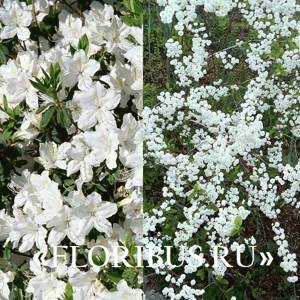
Types and characteristics of shrubs that bloom all summer
Let us tell you in more detail about the varieties of such plants and their characteristics.
Buddleya
Buddleya
This plant is known for its unpretentiousness. Another important feature of this shrub is its ability to bloom abundantly. Outwardly it resembles a lilac.
Buddleia is a fairly tall plant. An adult specimen can reach a height of 3 m. In addition, during flowering it is characterized by a light and pleasant aroma. Butterflies love the smell of buddleia and flock to this shrub. This adds an extra touch to the beautiful landscape.
The flowering period begins with the end of spring and the beginning of summer. It continues until the first frost. This variety of ornamental shrubs is often used to decorate slopes or to decorate borders.
Buddleia grows well in places that are well lit by the sun. However, these plants also grow well in the shade.
Hydrangea
This shrub is not difficult to care for. Its appearance is characterized by beautiful white inflorescences with a pleasant aroma. It is perennial.
It grows well not only in bright sunlight, but also in shaded areas. One of the beautiful features of this plant is the ability to change its color as it blooms.
Hydrangea
Weigela
The luxurious flowering of weigela is a striking feature of this variety of ornamental plants. Unlike some other species, it grows best in full sunlight. Planting it in the shade is not recommended. Adult specimens are quite tall. Their height can reach 2-3 meters.
Weigela
One common use is to create a hedge. Another interesting feature is its excellent compatibility with other plants when decorating the landscape. Low-growing varieties of this species can be successfully used in the design of flower beds along with the use of various flowers.
When caring for them, you must remember that in order for them to maintain their beautiful appearance, it is necessary to prune them, cutting off aging shoots at the base. This procedure must be used for adult plants of this species. This procedure is best performed during the summer. This shrub is usually planted in April.
Spirea
It is also known as meadowsweet. Its unpretentiousness is widely known. Of the ornamental plants of this type, it is considered one of the most undemanding. Here we are considering, first of all, the decorative features of plants, but it should be noted that spirea is also known for its medicinal properties.
In addition, it can be a seasoning for some dishes. But its features don’t end there. Spiraea is known for its strong aroma, which can sometimes even intoxicate.
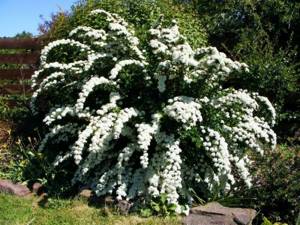
Spirea
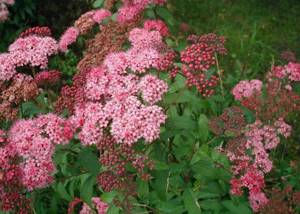
Spiraea Spiraea
This plant is perennial. Over time, over the years, its branches become more and more wooden. The height of the bush may vary. In some cases, the height of the plant can be no more than 50 cm, and some specimens can reach a height of 2.5 m.
The shape of the bush itself in various cases can be either erect or spherical or take on some other shape. It can be, for example, pyramidal or cascading. Flowering occurs throughout the summer, but the beginning and end of this period may vary in different cases.
In fact, spirea can be used in landscape design for almost any purpose.
Lilac
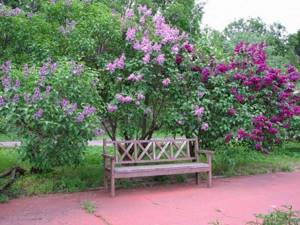
Lilac
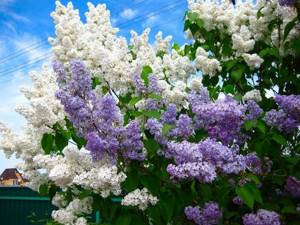
Lilac
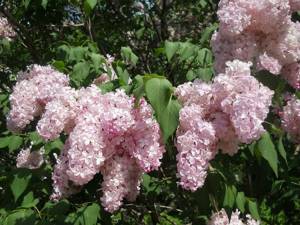
Lilac
Regular lilacs would be a good choice for use as decorative landscaping. One of its famous features is its lush flowers, with their own charming aroma. If you cut flowering branches and place them at home, they will stand for a long time and delight everyone with their beautiful appearance and wonderful aroma.
We must not forget that lilac, when growing, becomes a large, spreading bush. And, despite its obvious aesthetic advantages, this does not please everyone.
Because of this, it is common practice to prune this plant regularly to give it the desired size and shape. The plant tolerates winter cold well. In particularly harsh climates, special varieties of lilac that are especially cold-resistant are used.
Japonica

Japonica
This bush comes from Japan. He can be either tall or short. This makes it possible to choose the variety that is most suitable for you.
The quince will not need special care. In particular, it is very resistant to cold. Flowering begins in early spring and usually continues until mid-August. The shrub looks classic and elegant.
The bright flowers of this plant go well with the vibrant green color of the leaves.
Mock orange is confused with jasmine
Mock orange also belongs to the Hydrangeaceae family. This plant is often confused with jasmine. But their difference is that this perennial is less whimsical. This shrub, blooming with white flowers, is most often grown in our regions. All varieties are divided into two large groups. The first is dwarf perennials, up to 70-80 cm high. The second is tall. In the wild, the shrub grows up to 6 meters.
Mock orange blooms with white or cream flowers. They exude a very bright sweet aroma. Almost all varieties develop as perennial shrubs with pronounced trunks. The stems are covered with thin brownish-gray bark. The leaves are oval and arranged oppositely. The plates are large, up to 7-8 cm in length.
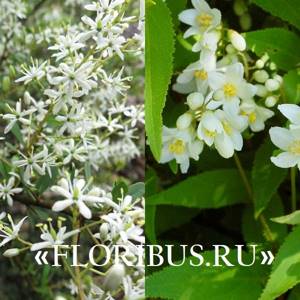
During the flowering period, mock orange produces numerous double or single flowers. The corolla looks like a cup, which, when opening, exudes a lovely aroma. Flowering does not last long - no more than three weeks. Despite this, the plant is highly valued by experienced gardeners.
Let's get to know shrubs and shrubs a little closer.
decorative bushes
From a scientific (botanical) point of view, a shrub is a life form of plants. As a rule, the above-ground area of a shrub contains several perennial woody shoots of approximately equal size, which extend from the base located near the ground or, more often, below its level. The shoots of a subshrub may not completely become lignified, but some of them still die off every year.
A tree, unlike a bush, has only one trunk. A separate botanical science, dendrology, studies tree forms. However, the diversity of real life forms, as always happens, cannot be defined in a simple diagram.
In everyday life, a bush and a shrub often turn out to be one and the same plant. But, for a knowledgeable, experienced gardener, a shrub is a botanical term, but a bush is simply a concept that is usually quite often used in horticultural literature to describe a lush plant formed by several above-ground shoots, both woody and herbaceous. In addition to shrubs and dwarf shrubs (in the botanical sense), this category would include trees that do not always produce a characteristic single trunk and grow almost in the form of a bush, and trees that can easily take the form of shrubs if the main shoot is damaged.
decorative shrubs photo
In the future, we will also get acquainted with subshrubs, although everyone traditionally considers them shrubs (raspberries) and with shrubs that behave like perennial herbaceous plants (tamarix, buddleia). Shrubs that differ from their counterparts in smaller growth and several rooting points, thus forming mats (lingonberries, cranberries), will not be left without attention. Dear readers, I would like to draw your attention to the fact that all the plants I describe are important in landscape design and a professional designer classifies all of them as shrubs.



